Constraints in Flutter Constraints go down. Sizes go up. Parent sets position.
Flutter layout can’t really be understood without knowing the rule
- A widget gets its own constraints from its parent. A constraint is just a set of 4 doubles: a minimum and maximum width, and a minimum and maximum height.
- Then the widget goes through its own list of children. One by one, the widget tells its children what their constraints are (which can be different for each child), and then asks each child what size it wants to be.
- Then, the widget positions its children (horizontally in the
xaxis, and vertically in theyaxis), one by one. - And, finally, the widget tells its parent about its own size (within the original constraints, of course).
For example, if a composed widget contains a column with some padding, and wants to lay out its two children as follows:

The negotiation goes something like this:
Widget: “Hey parent, what are my constraints?”
Parent: “You must be from 80 to 300 pixels wide, and 30 to 85 tall.”
Widget: “Hmmm, since I want to have 5 pixels of padding, then my children can have at most 290 pixels of width and 75 pixels of height.”
Widget: “Hey first child, You must be from 0 to 290 pixels wide, and 0 to 75 tall.”
First child: “OK, then I wish to be 290 pixels wide, and 20 pixels tall.”
Widget: “Hmmm, since I want to put my second child below the first one, this leaves only 55 pixels of height for my second child.”
Widget: “Hey second child, You must be from 0 to 290 wide, and 0 to 55 tall.”
Second child: “OK, I wish to be 140 pixels wide, and 30 pixels tall.”
Widget: “Very well. My first child has position x: 5 and y: 5, and my second child has x: 80 and y: 25.”
Widget: “Hey parent, I’ve decided that my size is going to be 300 pixels wide, and 60 pixels tall.”
Limitations
As a result of the layout rule mentioned above, Flutter’s layout engine has a few important limitations:
- A widget can decide its own size only within the constraints given to it by its parent. This means a widget usually can’t have any size it wants.
- A widget can’t know and doesn’t decide its own position in the screen, since it’s the widget’s parent who decides the position of the widget.
- Since the parent’s size and position, in its turn, also depends on its own parent, it’s impossible to precisely define the size and position of any widget without taking into consideration the tree as a whole.
- If a child wants a different size from its parent and the parent doesn’t have enough information to align it, then the child’s size might be ignored. Be specific when defining alignment.
Example 1

Container(color: red)The screen is the parent of the Container, and it forces the Container to be exactly the same size as the screen.
So the Container fills the screen and paints it red.
Example 2

Container(width: 100, height: 100, color: red)The red Container wants to be 100 × 100, but it can’t, because the screen forces it to be exactly the same size as the screen.
So the Container fills the screen.
Example 3
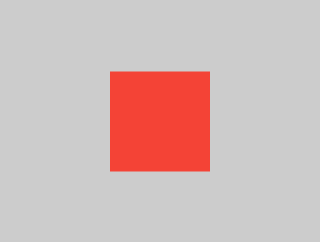
Center(
child: Container(width: 100, height: 100, color: red),
)The screen forces the Center to be exactly the same size as the screen, so the Center fills the screen.
The Center tells the Container that it can be any size it wants, but not bigger than the screen. Now the Container can indeed be 100 × 100.
Example 4
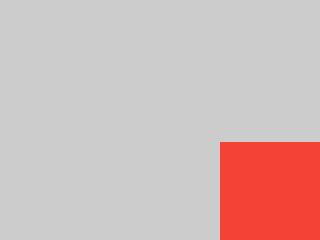
Align(
alignment: Alignment.bottomRight,
child: Container(width: 100, height: 100, color: red),
)This is different from the previous example in that it uses Align instead of Center.
Align also tells the Container that it can be any size it wants, but if there is empty space it won’t center the Container. Instead, it aligns the container to the bottom-right of the available space.
Example 5

Center(
child: Container(
width: double.infinity, height: double.infinity, color: red),
)The screen forces the Center to be exactly the same size as the screen, so the Center fills the screen.
The Center tells the Container that it can be any size it wants, but not bigger than the screen. The Container wants to be of infinite size, but since it can’t be bigger than the screen, it just fills the screen.
Example 6

Center(
child: Container(color: red),
)The screen forces the Center to be exactly the same size as the screen, so the Center fills the screen.
The Center tells the Container that it can be any size it wants, but not bigger than the screen. Since the Container has no child and no fixed size, it decides it wants to be as big as possible, so it fills the whole screen.
But why does the Container decide that? Simply because that’s a design decision by those who created the Container widget. It could have been created differently, and you have to read the Container documentation to understand how it behaves, depending on the circumstances.
Example 7

Center(
child: Container(
color: red,
child: Container(color: green, width: 30, height: 30),
),
)The screen forces the Center to be exactly the same size as the screen, so the Center fills the screen.
The Center tells the red Container that it can be any size it wants, but not bigger than the screen. Since the red Container has no size but has a child, it decides it wants to be the same size as its child.
The red Container tells its child that it can be any size it wants, but not bigger than the screen.
The child is a green Container that wants to be 30 × 30. Given that the red Container sizes itself to the size of its child, it is also 30 × 30. The red color isn’t visible because the green Container entirely covers the red Container.
Example 8
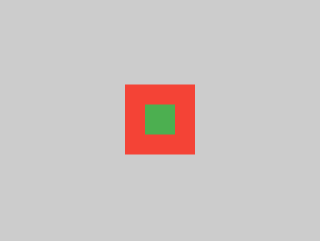
Center(
child: Container(
padding: const EdgeInsets.all(20.0),
color: red,
child: Container(color: green, width: 30, height: 30),
),
)The red Container sizes itself to its children’s size, but it takes its own padding into consideration. So it is also 30 × 30 plus padding. The red color is visible because of the padding, and the green Container has the same size as in the previous example.
Example 9

ConstrainedBox(
constraints: const BoxConstraints(
minWidth: 70,
minHeight: 70,
maxWidth: 150,
maxHeight: 150,
),
child: Container(color: red, width: 10, height: 10),
)You might guess that the Container has to be between 70 and 150 pixels, but you would be wrong. The ConstrainedBox only imposes additional constraints from those it receives from its parent.
Here, the screen forces the ConstrainedBox to be exactly the same size as the screen, so it tells its child Container to also assume the size of the screen, thus ignoring its constraints parameter.
Example 10
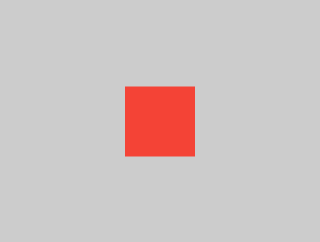
Center(
child: ConstrainedBox(
constraints: const BoxConstraints(
minWidth: 70,
minHeight: 70,
maxWidth: 150,
maxHeight: 150,
),
child: Container(color: red, width: 10, height: 10),
),
)Now, Center allows ConstrainedBox to be any size up to the screen size. The ConstrainedBox imposes additional constraints from its constraints parameter onto its child.
The Container must be between 70 and 150 pixels. It wants to have 10 pixels, so it ends up having 70 (the minimum).
Example 11
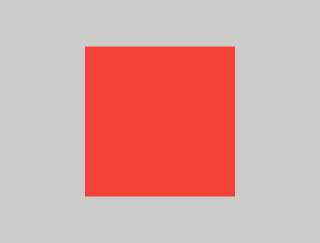
Center(
child: ConstrainedBox(
constraints: const BoxConstraints(
minWidth: 70,
minHeight: 70,
maxWidth: 150,
maxHeight: 150,
),
child: Container(color: red, width: 1000, height: 1000),
),
)Center allows ConstrainedBox to be any size up to the screen size. The ConstrainedBox imposes additional constraints from its constraints parameter onto its child.
The Container must be between 70 and 150 pixels. It wants to have 1000 pixels, so it ends up having 150 (the maximum).
Example 12

Center(
child: ConstrainedBox(
constraints: const BoxConstraints(
minWidth: 70,
minHeight: 70,
maxWidth: 150,
maxHeight: 150,
),
child: Container(color: red, width: 100, height: 100),
),
)Center allows ConstrainedBox to be any size up to the screen size. The ConstrainedBox imposes additional constraints from its constraints parameter onto its child.
The Container must be between 70 and 150 pixels. It wants to have 100 pixels, and that’s the size it has, since that’s between 70 and 150.
Example 13

UnconstrainedBox(
child: Container(color: red, width: 20, height: 50),
)The screen forces the UnconstrainedBox to be exactly the same size as the screen. However, the UnconstrainedBox lets its child Container be any size it wants.
Example 14
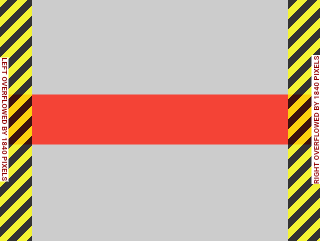
UnconstrainedBox(
child: Container(color: red, width: 4000, height: 50),
)The screen forces the UnconstrainedBox to be exactly the same size as the screen, and UnconstrainedBox lets its child Container be any size it wants.
Unfortunately, in this case the Container is 4000 pixels wide and is too big to fit in the UnconstrainedBox, so the UnconstrainedBox displays the much dreaded “overflow warning”.
Example 15
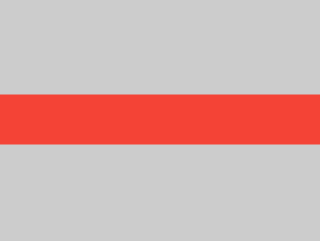
OverflowBox(
minWidth: 0.0,
minHeight: 0.0,
maxWidth: double.infinity,
maxHeight: double.infinity,
child: Container(color: red, width: 4000, height: 50),
)The screen forces the OverflowBox to be exactly the same size as the screen, and OverflowBox lets its child Container be any size it wants.
OverflowBox is similar to UnconstrainedBox; the difference is that it won’t display any warnings if the child doesn’t fit the space.
In this case, the Container has 4000 pixels of width, and is too big to fit in the OverflowBox, but the OverflowBox simply shows as much as it can, with no warnings given.
Example 16

UnconstrainedBox(
child: Container(color: Colors.red, width: double.infinity, height: 100),
)This won’t render anything, and you’ll see an error in the console.
The UnconstrainedBox lets its child be any size it wants, however its child is a Container with infinite size.
Flutter can’t render infinite sizes, so it throws an error with the following message: BoxConstraints forces an infinite width.
Example 17
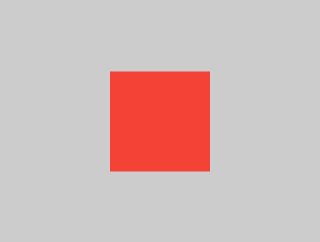
UnconstrainedBox(
child: LimitedBox(
maxWidth: 100,
child: Container(
color: Colors.red,
width: double.infinity,
height: 100,
),
),
)Here you won’t get an error anymore, because when the LimitedBox is given an infinite size by the UnconstrainedBox; it passes a maximum width of 100 down to its child.
If you swap the UnconstrainedBox for a Center widget, the LimitedBox won’t apply its limit anymore (since its limit is only applied when it gets infinite constraints), and the width of the Container is allowed to grow past 100.
This explains the difference between a LimitedBox and a ConstrainedBox.
Example 18
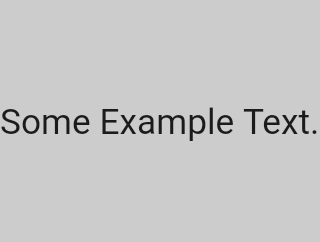
const FittedBox(
child: Text('Some Example Text.'),
)The screen forces the FittedBox to be exactly the same size as the screen. The Text has some natural width (also called its intrinsic width) that depends on the amount of text, its font size, and so on.
The FittedBox lets the Text be any size it wants, but after the Text tells its size to the FittedBox, the FittedBox scales the Text until it fills all of the available width.
Example 19

const Center(
child: FittedBox(
child: Text('Some Example Text.'),
),
)But what happens if you put the FittedBox inside of a Center widget? The Center lets the FittedBox be any size it wants, up to the screen size.
The FittedBox then sizes itself to the Text, and lets the Text be any size it wants. Since both FittedBox and the Text have the same size, no scaling happens.
Example 20
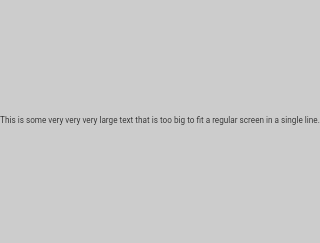
const Center(
child: FittedBox(
child: Text(
'This is some very very very large text that is too big to fit a regular screen in a single line.'),
),
)However, what happens if FittedBox is inside of a Center widget, but the Text is too large to fit the screen?
FittedBox tries to size itself to the Text, but it can’t be bigger than the screen. It then assumes the screen size, and resizes Text so that it fits the screen, too.
Example 21
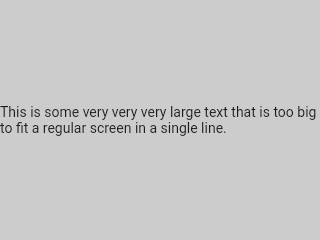
const Center(
child: Text(
'This is some very very very large text that is too big to fit a regular screen in a single line.'),
)If, however, you remove the FittedBox, the Text gets its maximum width from the screen, and breaks the line so that it fits the screen.
Example 22

FittedBox(
child: Container(
height: 20.0,
width: double.infinity,
color: Colors.red,
),
)FittedBox can only scale a widget that is bounded (has non-infinite width and height). Otherwise, it won’t render anything, and you’ll see an error in the console.
Example 23
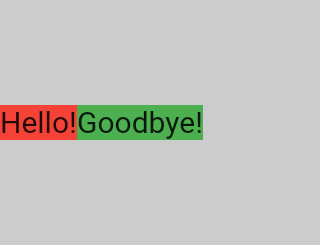
Row(
children: [
Container(color: red, child: const Text('Hello!', style: big)),
Container(color: green, child: const Text('Goodbye!', style: big)),
],
)The screen forces the Row to be exactly the same size as the screen.
Just like an UnconstrainedBox, the Row won’t impose any constraints onto its children, and instead lets them be any size they want. The Row then puts them side-by-side, and any extra space remains empty.
Example 24
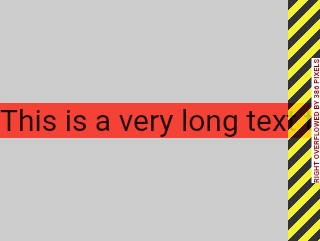
Row(
children: [
Container(
color: red,
child: const Text(
'This is a very long text that '
'won\'t fit the line.',
style: big,
),
),
Container(color: green, child: const Text('Goodbye!', style: big)),
],
)Since Row won’t impose any constraints onto its children, it’s quite possible that the children might be too big to fit the available width of the Row. In this case, just like an UnconstrainedBox, the Row displays the “overflow warning”.
Example 25
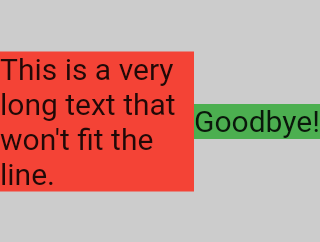
Row(
children: [
Expanded(
child: Center(
child: Container(
color: red,
child: const Text(
'This is a very long text that won\'t fit the line.',
style: big,
),
),
),
),
Container(color: green, child: const Text('Goodbye!', style: big)),
],
)When a Row’s child is wrapped in an Expanded widget, the Row won’t let this child define its own width anymore.
Instead, it defines the Expanded width according to the other children, and only then the Expanded widget forces the original child to have the Expanded’s width.
In other words, once you use Expanded, the original child’s width becomes irrelevant, and is ignored.
Example 26
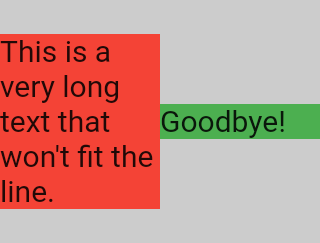
Row(
children: [
Expanded(
child: Container(
color: red,
child: const Text(
'This is a very long text that won\'t fit the line.',
style: big,
),
),
),
Expanded(
child: Container(
color: green,
child: const Text(
'Goodbye!',
style: big,
),
),
),
],
)If all of Row’s children are wrapped in Expanded widgets, each Expanded has a size proportional to its flex parameter, and only then each Expanded widget forces its child to have the Expanded’s width.
In other words, Expanded ignores the preferred width of its children.
Example 27
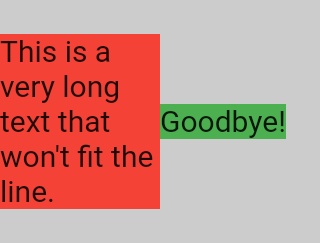
Row(
children: [
Flexible(
child: Container(
color: red,
child: const Text(
'This is a very long text that won\'t fit the line.',
style: big,
),
),
),
Flexible(
child: Container(
color: green,
child: const Text(
'Goodbye!',
style: big,
),
),
),
],
)The only difference if you use Flexible instead of Expanded, is that Flexible lets its child have the same or smaller width than the Flexible itself, while Expanded forces its child to have the exact same width of the Expanded. But both Expanded and Flexible ignore their children’s width when sizing themselves.
Example 28
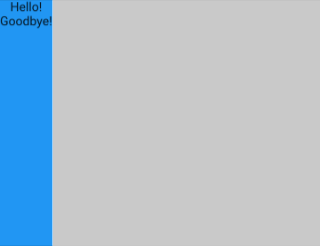
Scaffold(
body: Container(
color: blue,
child: Column(
children: const [
Text('Hello!'),
Text('Goodbye!'),
],
),
),
)The screen forces the Scaffold to be exactly the same size as the screen, so the Scaffold fills the screen. The Scaffold tells the Container that it can be any size it wants, but not bigger than the screen.
Example 29

Scaffold(
body: SizedBox.expand(
child: Container(
color: blue,
child: Column(
children: const [
Text('Hello!'),
Text('Goodbye!'),
],
),
),
),
)If you want the Scaffold’s child to be exactly the same size as the Scaffold itself, you can wrap its child with SizedBox.expand.
Tight vs. loose constraints
It’s very common to hear that some constraint is “tight” or “loose”, so it’s worth knowing what that means.
A tight constraint offers a single possibility, an exact size. In other words, a tight constraint has its maximum width equal to its minimum width; and has its maximum height equal to its minimum height.
If you go to Flutter’s box.dart file and search for the BoxConstraints constructors, you’ll find the following
BoxConstraints.tight(Size size)
: minWidth = size.width,
maxWidth = size.width,
minHeight = size.height,
maxHeight = size.height;
If you revisit Example 2 above, it tells us that the screen forces the red Container to be exactly the same size as the screen. The screen does that, of course, by passing tight constraints to the Container.
A loose constraint, on the other hand, sets the maximum width and height, but lets the widget be as small as it wants. In other words, a loose constraint has a minimum width and height both equal to zero:
BoxConstraints.loose(Size size)
: minWidth = 0.0,
maxWidth = size.width,
minHeight = 0.0,
maxHeight = size.height;
If you revisit Example 3, it tells us that the Center lets the red Container be smaller, but not bigger than the screen. The Center does that, of course, by passing loose constraints to the Container. Ultimately, the Center’s very purpose is to transform the tight constraints it got from its parent (the screen) to loose constraints for its child (the Container).
Learning the layout rules for specific widgets
Knowing the general layout rule is necessary, but it’s not enough.
Each widget has a lot of freedom when applying the general rule, so there is no way of knowing what it will do by just reading the widget’s name.
If you try to guess, you’ll probably guess wrong. You can’t know exactly how a widget behaves unless you’ve read its documentation, or studied its source-code.
The layout source-code is usually complex, so it’s probably better to just read the documentation. However, if you decide to study the layout source-code, you can easily find it by using the navigating capabilities of your IDE.
Here is an example:
- Find a
Columnin your code and navigate to its source code. To do this, usecommand+B(macOS) orcontrol+B(Windows/Linux) in Android Studio or IntelliJ. You’ll be taken to thebasic.dartfile. SinceColumnextendsFlex, navigate to theFlexsource code (also inbasic.dart). - Scroll down until you find a method called
createRenderObject(). As you can see, this method returns aRenderFlex. This is the render-object for theColumn. Now navigate to the source-code ofRenderFlex, which takes you to theflex.dartfile. - Scroll down until you find a method called
performLayout(). This is the method that does the layout for theColumn.


